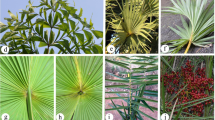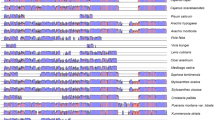Abstract
Phylogenies of the palm family based on DNA sequences from thetrnL —trnF region of the chloroplast genome are presented. Although the region is highly conserved in palms and relatively few sites in the aligned data matrix are parsimony informative, a variety of relationships among members of the family are revealed by the analyses, some of which are congruent with the current classification of the palms, and others which are not. However, consensus trees contain high levels of ambiguosity, partly due to the inadequate numbers of informative characters in the dataset. Additional data are required before well resolved palm phylogenies can be generated.
Similar content being viewed by others
References
Asmussen C. B., Doyle J. J. (1997) Therpl16 intron as potential genetic marker within the palm family (Arecaceae). Amer. J. Bot. Abstracts 84: 174.
Baker W. J. (1997) Systematic studies of the calamoid palms. PhD Thesis, University of Reading.
Baker W. J., Asmussen C. B., Barrow S., Dransfield J., Hedderson T. A. (1997) A molecular phylogeny for the palm family (Arecaceae) based on chloroplast DNA sequence data. Amer. J. Bot. Abstracts 84: 176.
Baker W. J., Dransfield J., Harley M. M., Bruneau A. (1999) Morphology and cladistic analysis of subfamily Calamoideae (Palmae). In: Henderson A., Borchsenius F. (eds.) Evolution, variation and classification of palms. Mem. New York Bot. Gard. 83: 307–323.
Barrow S. (1996) A Monograph ofPhoenix L. (Palmae: Coryphoideae). PhD Thesis, University of Reading.
Böhle U.-R., Hilger H., Cerff R., Martin W. F. (1994) Non-coding chloroplast DNA for plant molecular systematics at the infrageneric level. In: Schierwater B., Streit B., Wagner G. P., DeSalle R. (eds.) Molecular ecology and evolution: approaches and applications. Birkhäuser, Basel, pp. 391–403.
Chase M. W., Duvall M. R., Hills H. G., Conran J. G., Cox A. V., Eguiarte L. E., Hartwell J., Fay M. F., Caddick L. R., Cameron K. M., Hoot S. (1995a) Molecular phylogenetics of the Lilianae. In: Rudall P. J., Cribb P. J., Cutler D. F., Humphries C. J. (eds.) Monocotyledons: systematics and evolution. Royal Botanic Gardens, Kew, pp. 109–138.
Chase M. W., Soltis D. E., Olmstead R. G., Morgan D., Les D. H., Mishler B. D., Duvall M. R., Price R. A., Hills H. G., Qiu Y.-L., Kron K. A., Rettig J. H., Conti E., Palmer J. D., Manhart J. R., Sytsma K. J., Michaels H. J., Kress W. J., Karol K. G., Clark W. D., Hedrén M., Gaut B. S., Jansen R. K., Kim K.-J., Wimpee C. F., Smith J. F., Furnier G. R., Strauss S. H., Xiang Q.-Y., Plunkett G. M., Soltis P. S., Swensen S. M., Williams S. E., Gadek P. A., Quinn C. J., Eguiarte L. E., Golenberg E., Learn G. H. Jr., Graham S. W., Barrett S. C. H., Dayanandan S., Albert V. A. (1993) Phylogenetics of seed plants: an analysis of nucleotide sequences from the plastid generbcL. Ann. Missouri Bot. Gard. 80: 528–580.
Chase M. W., Stevenson D. W., Wilkin P., Rudall P. J. (1995b) Monocot systematics: a combined analysis. In: Rudall P. J., Cribb P. J., Cutler D. F., Humphries C. J. (eds.) Monocotyledons: systematics and evolution. Royal Botanic Gardens, Kew, pp. 685–730.
Dransfield J., Uhl N. W. (1986) An outline classification of palms. Principes 30: 3–12.
Doyle J. J., Doyle J. L. (1987) A rapid DNA isolation procedure for small quantities of fresh leaf tissue. Phytochem. Bull. 19: 11–15.
Drude O. (1887) Palmae. In: Engler A., Prantl K. (eds.) Die Natürlichen Pflanzenfamilien 2(3): 1–93. Verlag von Wilhelm Engelmann, Leipzig.
Farris J. S. (1969) A successive approximations approach to character weighting. Syst. Zool. 18: 374–385.
Farris J. S. (1989) The retention index and the rescaled consistency index. Cladistics 5: 417–419.
Farris J. S. (1995) Parsimony Jackknifer, Version 4.22. Distributed by the author.
Farris J. S., Albert V. A., Källersjö M., Lipscomb D., Kluge A. G. (1996) Parsimony jackknifing outperforms neighbor-joining. Cladistics 12: 99–124.
Ferris C., Oliver R. P., Davy A. J., Hewitt G. M. (1993) Native oak chloroplasts reveal an ancient divide across Europe. Molec. Ecol. 2: 337–344.
Ferris C., Oliver R. P., Davy A. J., Hewitt G. M. (1995) Using chloroplast DNA to trace postglacial migration routes of oaks into Britain. Molec. Ecol. 4: 731–738.
Ferris C., King R. A., Gray A. J. (1997) Molecular evidence for the maternal parentage in the hybrid origin ofSpartina anglica C. E. Hubbard. Molec. Ecol. 6: 185–187.
Gaut B. S., Morton B. R., McCaig B. C., Clegg M. T. (1996) Substitution rate comparisons between grasses and palms: synonymous rate differences at the nuclear geneAdh parallel rate differences at the plastid generbcL. Proc. Natl. Acad. U.S.A. 93: 10274–10279.
Gielly L., Taberlet P. (1994) The use of chloroplast DNA to resolve plant phylogenies: noncoding versusrbcL sequences. Molec. Biol. Evol. 11: 769–777.
Gielly L., Taberlet P. (1996) A phylogeny of the European gentians inferred from chloroplasttrnL (UAA) intron sequences. Bot. J. Linn. Soc. 120: 57–75.
Gielly L., Yuan Y. M., Küpfer P., Taberlet P. (1996) Phylogenetic use of noncoding regions in the genusGentiana L.: chloroplasttrnL (UAA) intron versus nuclear ribosomal internal transcribed spacer sequences. Molec. Phyl. Evol. 5: 460–466.
Givnish T. J., Sytsma K. J. (1997) Consistency, characters, and the likelihood of correct phylogenetic inference. Molec. Phyl. Evol. 7: 320–330.
Goloboff P. A. (1993) Estimating character weights during tree search. Cladistics 9: 83–91.
Ham R. C. H. J. van, Hart H. 'T, Mes T. H. M., Sandbrink J. M., (1994) Molecular evolution of noncoding regions of the chloroplast genome in the Crassulaceae and related species. Current Genetics 25: 558–566.
Hillis D. M., Huelsenbeck J. P. (1992) Signal, noise, and reliability in molecular phylogenetic analyses. J. Heredity 83: 189–195.
Kim J. H., Hart H. 'T, Mes T. H. M. (1996) The phylogenetic position of East AsianSedum species (Crassulaceae) based on chloroplast DNAtrnL (UAA) —trnF (GAA) intergenic spacer sequence variation. Acta Bot. Neerl. 45: 309–321.
Kita Y., Ueda K., Kadota Y. (1995) Molecular phylogeny and evaluation of the AsianAconitum subgenusAconitum (Ranunculaceae). J. Pl. Res. 108: 429–442.
Martius C. F. P. von (1823–1850) Historia Naturalis Palmarum. T. O. Weigel, Leipzig.
Mes T. H. M., Hart, H. 'T (1994)Sedum surculosum andS. jaccardianum (Crassulaceae) share a unique 70 bp deletion in the chloroplast DNAtrnL (UAA) —trnF (GAA) intergenic spacer. Plant Syst. Evol. 193: 213–221.
Mes T. H. M., van Brederode J., Hart H. 'T (1996) Origin of the woody macaronesianSempervivoideae and the phylogenetic position of the East African species ofAeonium. Bot. Acta 109: 477–491.
Mes T. H. M., Wiejers G. J., Hart H. 'T (1997) Phylogenetic relationships inMonanthes (Crassulaceae) based on morphological, chloroplast and nuclear DNA variation. J. Evol. Biol. 10: 193–216.
Moore H. E. (1973) The major groups of palms and their distribution. Gentes Herb. 11: 27–141.
Schrank E. (1994) Palynology of the Yesomma formation in northern Somalia: a study of pollen, spores and associated phytoplankton from the Late Cretaceous Palmae Province. Paleontographica 231: 63–112.
Taberlet P., Gielly L., Pautou G., Bouvet J. (1991) Universal primers for amplification of three noncoding regions of chloroplast DNA. Pl. Molec. Biol. 17: 1105–1109.
Uhl N. W., Dransfield J. (1987) Genera Palmarum: a classification of palms based on the work of H. E. Moore, Jr. International Palm Society and L. H. Bailey Hortorium, Lawrence, KS, pp. 1–610.
Uhl N. W., Dransfield J. (1999) Genera Palmarum: after ten years. In: Henderson A., Borchsenius F. (eds.) Evolution and classification of palms. Mem. New York Bot. Gard. 83: 245–253.
Uhl N. W., Dransfield J., Davis J. I., Luckow M. A., Hansen K. S., Doyle J. J. (1995) Phylogenetic relationships among palms: cladistic analyses of morphological and chloroplast DNA restriction site variation. In: Rudall P. J., Cribb P. J., Cutler D. F., Humphries C. J. (eds.) Monocotyledons: systematics and evolution. Royal Botanic Gardens, Kew, pp. 623–661.
Wilson M. A., Gaut B., Clegg M. T. (1990) Chloroplast DNA evolves slowly in the palm family (Arecaceae). Molec. Biol. Evol. 7: 303–314.
Author information
Authors and Affiliations
Corresponding author
Rights and permissions
About this article
Cite this article
Baker, W.J., Asmussen, C.B., Barrow, S.C. et al. A phylogenetic study of the palm family (Palmae) based on chloroplast DNA sequences from thetrnL —trnF region. Pl Syst Evol 219, 111–126 (1999). https://doi.org/10.1007/BF01090303
Received:
Accepted:
Issue Date:
DOI: https://doi.org/10.1007/BF01090303




